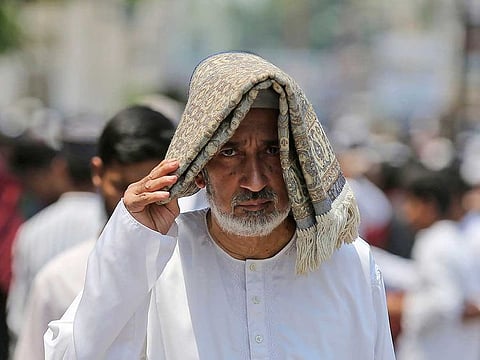Power cuts, forest fires in India heatwave
Wheat crops hit, power cuts blamed on shortages of coal

New Delhi: Power outages compounded the misery of millions of people wilting in a heatwave across India on Friday, with experts blaming climate change for an early onset of roasting summer temperatures.
In the northern Indian state of Himachal Pradesh hundreds of forest fires have broken out in recent weeks, eating up tinder-dry pine forests including around Dharamsala, home of the Dalai Lama.
Himachal Pradesh normally sees rain, hail and even snow in higher areas at this time of year but many parts have seen no precipitation in two months, sparking more and bigger blazes than normal.
“Teams of firefighters are working hard to put out these fires and also to save wild animals,” state forest chief Ajay Srivastava told AFP.
Power cuts were partly blamed on shortages of coal after an unusually hot March and April pushed up power demand and ate up stockpiles.
In the teeming Indian megacity of New Delhi, which hit 43 degrees Celsius on Friday, authorities said many power stations had “less than a day’s coal left”.
“The situation in entire India is dire,” said Arvind Kejriwal, Delhi’s chief minister, warning of potential power cuts to hospitals and the city’s metro.
A fire at a landfill 60 metres (almost 200 feet) high in Delhi was still smouldering on Friday for a fourth day.
Indian states including Rajasthan, Gujarat and Andhra Pradesh have cut back power supply to industrial areas because of coal shortages at power stations.
India also cancelled some passenger trains to allow for faster movement of coal at power plants in a bid to avoid a full-blown crisis, Bloomberg News reported.
In Kolkata, drooping public transport passengers were being given glucose water after a spate of cases of heatstroke in recent days.
“With no rain for over 57 days, Kolkata is in the grip of the longest dry spell of this millennium,” said Sanjit Bandyopadhyay from the Regional Meteorological Centre.
Coming during the month of Ramadan, the heat makes fasting in India even tougher for Muslims.
When the sun sets, vendors are doing a roaring trade in Rooh Afza, a sugary pink drink that has been quenching thirst for generations across the subcontinent.
In India authorities were closing schools or reducing hours, with Bihar ordering classes to stop by 10:45 am and advising people not to be outside after midday.
In the Bihar state capital Patna, heatstroke cases have jumped in the last 10 days and the number of children with fever, vomiting and diarrhoea has increased.
“People have been staying inside their house in day time. We are struggling to earn a livelihood,” said Rameshwar Paswan, a rickshaw puller.
Previously, India saw such temperatures in April only once every 50 years but now they come around every four, said Mariam Zachariah from the Grantham Institute at Imperial College London.
“Until net emissions are halted, it will continue to become even more common,” she said.
Wheat hit
An unusually early, record-shattering heat wave in India has reduced wheat yields.
Wheat is very sensitive to heat, especially during the final stage when its kernels mature and ripen. Indian farmers time their planting so that this stage coincides with India’s usually cooler spring.
Farm workers like Baldev Singh are among the most vulnerable. Singh, a farmer in Sangrur in northern India’s Punjab state, watched his crop shrivel before his eyes as an usually cool spring quickly shifted to unrelenting heat. He lost about a fifth of his yield. Others lost more.
``I am afraid the worst is yet to come,’’ Singh said.
Punjab is India’s ``grain bowl” and the government has encouraged cultivation of wheat and rice here since the 1960s. It is typically the biggest contributor to India’s national reserves and the government had hoped to buy about a third of this year’s stock from the region.
But government assessments predict lower yields this year, and Devinder Sharma, an agriculture policy expert in northern Chandigarh city, said he expected to get 25% less.
Even though it is the world’s second-largest producer of wheat, India exports only a small fraction of its harvest.
It had been looking to capitalize on the global disruption to wheat supplies from Russia’s war in Ukraine and find new markets for its wheat in Europe, Africa, and Asia.
Sign up for the Daily Briefing
Get the latest news and updates straight to your inbox



